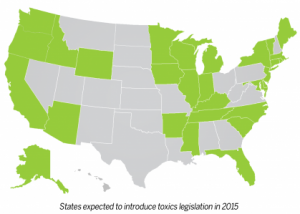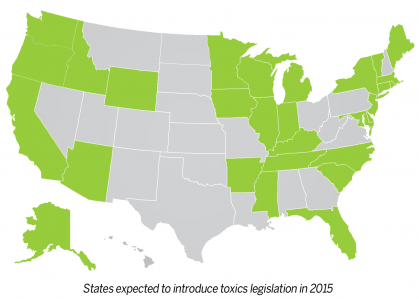Federal reform of our broken national toxics law may be decades overdue, but our friends at S afer States say at least 28 states will propose policies in the next year to reduce exposures to untested and toxic chemicals in consumer products. Do you live in one of these states? Want to help be a part of the action? Read on.
afer States say at least 28 states will propose policies in the next year to reduce exposures to untested and toxic chemicals in consumer products. Do you live in one of these states? Want to help be a part of the action? Read on.
The proposed laws come in all shapes and sizes. Some have good shot at passing, some will be heavily opposed by the chemical industry. Some are comprehensive and some are focused on specific harmful chemicals. Chemicals under scrutiny include flame retardants, components of plastics, and preservatives like formaldehyde found in cosmetics and consumer products. States are also moving to empower consumers with information about chemicals in products and to require manufacturers to provide public information.
Here’s the seven trends Safer States is watching:
1. Identification and disclosure of chemicals harmful to kids. At least twelve states will consider policy to: identify chemicals of concern; and/or require makers of consumer products to disclose chemicals of concern; and/or phase out chemicals of concern. California, Connecticut, Delaware, Florida, Massachusetts, Maine, Michigan, Minnesota, New York, Oregon, Vermont, and Washington.
2. Toxic Flame Retardants. At least eleven states and the District of Columbia will consider policy to phase out the use of and/or require labeling of toxic flame retardants in certain consumer products. Alaska, California, Connecticut, Idaho, Kentucky, Massachusetts, Michigan, Minnesota, New York, Tennessee and Washington.
3. Phthalates. At least five states will consider policy to keep phthalates out of jewelry, childcare products, cosmetics and other consumer products. Maine, Michigan, Mississippi, New Jersey, and New York.
4. Lead. At least five states will consider policy to address lead in paint, kids’ products, electronics and other products. Illinois, Indiana, Mississippi, New Jersey and New York.
5. Bisphenol A. At least six states will consider addressing the endocrine disruptor BPA in kids’ products, food packaging and other products. Connecticut, Delaware, Massachusetts, Maryland, New Jersey, and New York
6. Cadmium. At least four states will consider restricting cadmium in jewelry and kids’ products. Illinois, Mississsippi, New Jersey and New York.
7. Bonus policy efforts. Less-toxic cleaning supplies in schools (Arizona, Massachusetts, New Jersey); restrictions on mercury (Arkansas, California, Illinois, New Jersey and New York); restrictions on triclosan (Iowa); restrictions on synthetic turf (California, New York); green procurement strategies (Connecticut, New Jersey, Vermont); restrictions on formaldehyde in children’s personal care products (New York, South Carolina); restrictions on microbeads (Connecticut, Vermont and Wyoming); and policies yet to be determined (North Carolina, Rhode Island).
YOUR TURN!
You can be a part of the change!! Safer States has a list of organizations broken out by individual state here. It’s an easy way to be a voice where you live and fight for safer chemicals. Also, join our effort to enact real, meaningful federal reform. Visit our homepage and sign up to get alerts.




